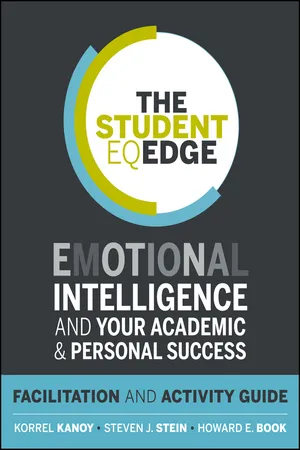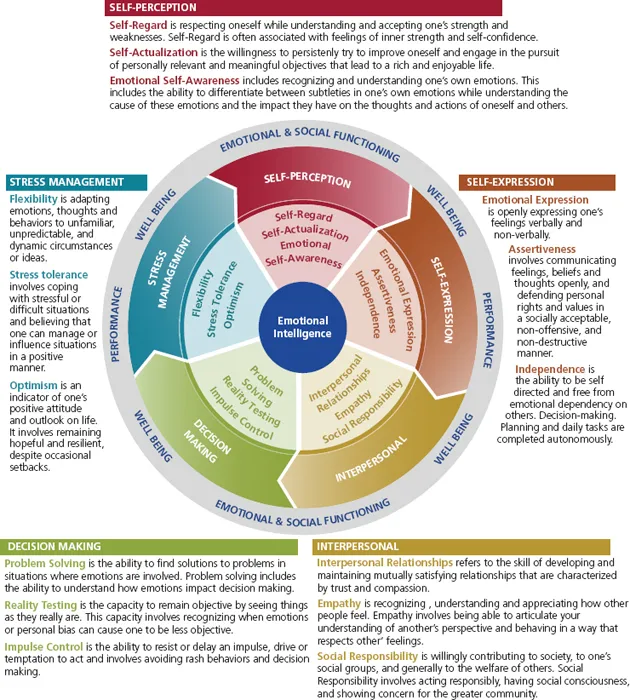
The Student EQ Edge
Emotional Intelligence and Your Academic and Personal Success: Facilitation and Activity Guide
- English
- ePUB (mobile friendly)
- Available on iOS & Android
The Student EQ Edge
Emotional Intelligence and Your Academic and Personal Success: Facilitation and Activity Guide
About This Book
THE STUDENT EQEDGE Facilitation and Activity Guide
This Facilitation and Activity Guide is a companion to the book The Student EQ Edge: Emotional Intelligence and Your Academic and Personal Success. It offers faculty and facilitators a hands-on resource for helping students reach their potential by tapping into the power of emotional intelligence. The Facilitation Guide includes exercises and activities which are designed to help students develop confidence, independence, the ability to set and meet goals, impulse control, social responsibility, problem-solving skills, stress tolerance, and much more—all of which help improve academic success. The Guide also contains a wealth of illustrative case studies, questions for student reflection, movie selections and TV shows that illustrate emotional intelligence, and a self-development plan.
"The single best resource on emotional intelligence in student affairs, The Student EQ Edge: Student Workbook and Facilitation and Activity Guide are well organized, creative, and offer everything an emotional intelligence facilitator would need in a fast-paced student affairs environment. The examples are soundly constructed and resonate with students. These materials are my go-to resources."—Candice Johnston, associate director of student leadership and organizations, Wake Forest University"If I were building a new course to improve student success, it would be founded on emotional intelligence. All the instruction in the world on 'study skills' cannot touch the advantages that come to students who are able to manage their emotional intelligence. And the best news of all is that these skills can be taught. EQ skills make the difference." —Randy L. Swing, executive director, Association for Institutional Research
"This Facilitation and Activity Guide is particularly useful, offering options from which the facilitator can draw in preparing assignments or learning community meetings. The focus on learners' needs, and particularly an authentic exploration of self and purpose, is practical yet has the potential to draw students to a deeper understanding of self that will draw them to high performance and contribution to others."—Dennis Roberts, assistant vice president for faculty and student services for the Qatar Foundation
Frequently asked questions
Information
Chapter 1
Introduction to the Facilitation and Activity Guide
EMOTIONAL INTELLIGENCE DEFINED AND RESEARCH OVERVIEW
- Social responsibility, followed by impulse control and empathy, were the three strongest positive predictors of college graduation.
- Self-actualization, social responsibility, and happiness were positive predictors of cumulative GPA, but very high independence and interpersonal relationship skills were negative predictors of cumulative GPA. Students who will not ask for help when they need it (high independence) tend not to do as well as those who seek help from Learning Centers, Career Centers, or Counseling Centers. And if a student is too skilled at interpersonal relationships, it’s likely that person spends more time doing just that—interacting with others—which leaves less time for study.

PLANNING YOUR CLASSES
STUDENT REFLECTION
- Reflection questions are included on the student worksheets. Ask students to submit written responses or to think about their responses prior to class discussion, or include the questions during the in-class debrief.
- In-class debrief questions should be discussed in class after the worksheet or activity has been completed. Debriefs are designed to solidify learning and insights related to an activity.
STUDENT EMOTIONAL INTELLIGENCE ASSESSMENT
FACILITATING CLASS DISCUSSIONS
- Personal information that is shared does not get repeated outside of class.
- Use conventions of good interaction, including not interrupting others, not dominating the conversation, and not judging others’ comments.
- Everyone must participate some of the time and listen all of the time.
AGREE-DISAGREE ACTIVITIES
ORGANIZATION OF THIS GUIDE
- Student Learning Outcomes
- Suggested Reading, Movies, and TV Shows—students love watching movie or TV clips; these clips are very effective for demonstrating EI concepts, and watching others demonstrate effective or ineffective EI makes the concepts come alive.
- A list of activities by name, with a brief description.
- A step-by-step guide for preparing to lead the activity, facilitating it, and debriefing it, and the expected time each will take.
- A copy of the worksheet found in The Student EQ Edge: Student Workbook.
MATERIALS
- White board or flip chart
- Markers
- TV with DVD or VCR player
- Internet connection (if you want to access TV clips through www.hulu.com or YouTube clips)
Table of contents
- Cover
- Contents
- Title
- Copyright
- Preface
- About the Authors
- Chapter 1: Introduction to the Facilitation and Activity Guide
- Chapter 2: Case Studies of Emotionally Intelligent (and Not Emotionally Intelligent!) Behavior
- Chapter 3: Emotional Self-Awareness
- Chapter 4: Self-Regard
- Chapter 5: Self-Actualization
- Chapter 6: Emotional Expression
- Chapter 7: Independence
- Chapter 8: Assertiveness
- Chapter 9: Interpersonal Relationship
- Chapter 10: Empathy
- Chapter 11: Social Responsibility
- Chapter 12: Reality Testing
- Chapter 13: Problem Solving
- Chapter 14: Impulse Control
- Chapter 15: Flexibility
- Chapter 16: Stress Tolerance
- Chapter 17: Optimism
- Chapter 18: Happiness
- References
- Appendix A: Model Syllabus
- Appendix B: Sample Grading Rubric for EI Reflection Questions
- Appendix C: Movie Selections for Teaching Emotional Intelligence
- Appendix D: Self-Development Plan for Improving Emotional Intelligence
- Appendix E: Resources for Teaching Emotional Intelligence